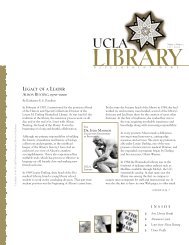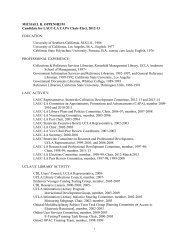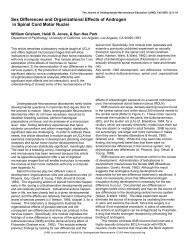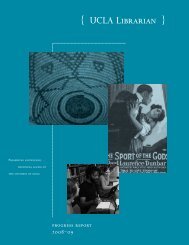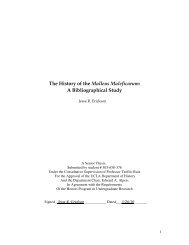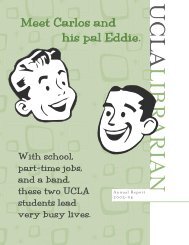Research Paper - UCLA Library
Research Paper - UCLA Library
Research Paper - UCLA Library
You also want an ePaper? Increase the reach of your titles
YUMPU automatically turns print PDFs into web optimized ePapers that Google loves.
Queen, Gloriana: The Portraits of Queen Elizabeth I, “When Elizabeth I succeeded her sister in<br />
Gu 9<br />
1558 she inherited a working tradition, but in her case it was to have one fundamental difference:<br />
she was never to have a court painter well paid by the crown and hence be able to sustain<br />
government control over her own image” (Strong, Gloriana 12). From the beginning, the<br />
Elizabethan regime lacked absolute control over the image of its new monarch, an issue<br />
especially problematic for a queen whose mother had been executed and had been third in line to<br />
inherit the throne. Early portraits of the young princess Elizabeth revealed nothing special about<br />
the future monarch; they presented what may be assumed to be a fairly accurate image of what<br />
she actually looked like rather than portraying Elizabeth as the embodiment of kingly virtues and<br />
power.<br />
The later portraits of Elizabeth, however, show the Queen “advanced from a stiff but still<br />
recognizable human being to an icon, the apotheosized ruler of the post-Armada years” (Strong,<br />
Gloriana 77). In contrast with her predecessors, Elizabeth’s images were not simply artistic<br />
depictions of the current monarch, but a work of art meant to be copied and disseminated<br />
throughout the homes of her subjects. Noblemen often collected portraits of the female monarch<br />
to be displayed in their homes and, in the middle of the 1580s, it became fashionable for<br />
noblemen to carry miniatures of Elizabeth around as a sign of loyalty to the crown and to the<br />
Queen. The demand for images of the Queen was so high that the Privy Council had to ban hack<br />
renditions of known designs, which could endanger the Elizabethan message through its poor<br />
quality. 3 Furthermore, Elizabeth’s profile was placed on coinage and as Julia Walker points out,<br />
“the simple image of the queen, the profile on the coin, was recognizable to all, even if<br />
distinguished from other such images only by her gender. For the first time in medieval and<br />
3 The main source for the miniatures and woodcuts was Nicholas Hilliard, who supplied the designs for Elizabeth’s<br />
image. In Gloriana, Strong shows how templates of the Queen’s face were replicated in numerous portraits with<br />
different clothing switched in.



